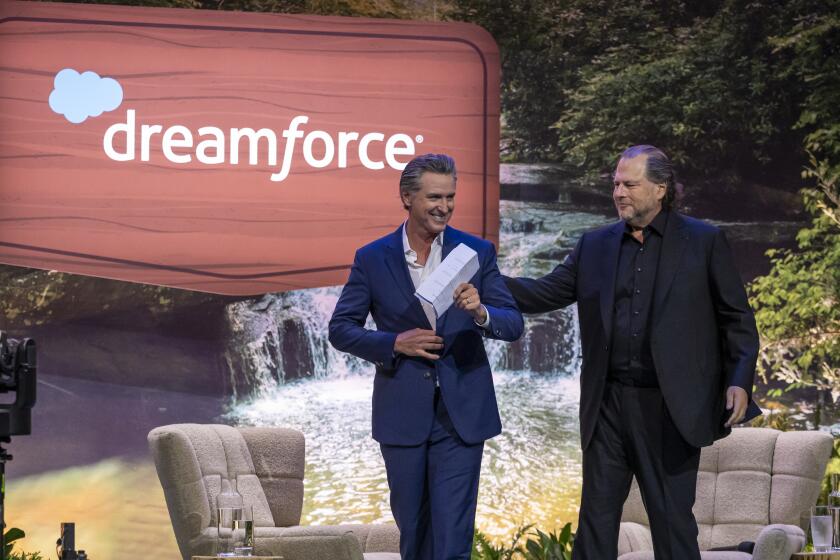Lean, Mean Byting Machine
For the better part of a decade the personal computer industry has leaped one technological hurdle after another. Ever-faster microprocessors, ever-bigger memories and a host of advances in communications and display capabilities have all made the desktop computer an appliance of stunning versatility.
But only this year has the industry cracked a barrier that is critical to many consumers: price.
Home computer buyers hitting the stores this yuletide will find the first systems ever priced at less than $1,000, yet powerful enough to run the latest software without flinching. (As always, the quoted list prices do not include monitors, which start at around $200.)
As the PC industry gathers for the annual Comdex trade show, the new machines represent an opportunity and a challenge for companies long accustomed to selling overpowered $2,500 boxes to a complaisant public.
For one thing, they give the industry its best chance in years to jog the personal computer’s still-anemic U.S. household penetration. The ratio of homes with at least one PC has been stuck in the 38% to 40% range since about 1995. Many market professionals believe that figure may finally inch up to 50% or better by 2000, thanks to the new machines.
“There’s been a tremendous amount of customer interest,” agrees Robert King, a computer manager at the CompUSA store in Long Beach, where racks of machines from Compaq, Hewlett-Packard and Packard Bell are attracting the attention of customers who have never owned a computer before.
“A lot of them are people who come in looking for maybe a refurbished computer,” he says. “But they see these and realize there’s almost no difference in price to buy a new one.”
But the surging popularity of the low-priced boxes may also be a sign that home computer buyers have become wise to the industry’s habit of selling home users more machine (and more costly machines) than they really need.
Even in comparison with the $3,000 full-featured models, today’s $999 computers have “immense hard drives, [top-of-the-line] 33.6-kbps modems and 8x CD-ROM drives,” says James Perhune, a PC market analyst for the Boston-based Yankee Group. “So what is the extra $2,000 buying? If my main applications are word processing, e-mail, going online and spreadsheets, there’s not a lot I can’t do with a low-end machine.”
That’s especially true given the bottlenecks in the fastest-growing application: the Internet. Because of slow modem speeds, staticky phone lines and network traffic jams, downloading a page from the World Wide Web on a turbocharged Pentium II monster PC is often not faster than on a $1,000 off-the-rack model.
As that understanding spreads through the consumer sector, it could rattle the very economic structure of the computing industry. Earnings for chip manufacturers like Intel and software giants like Microsoft have long depended on an unrelenting and accelerating cycle of upgrades.
Whenever Intel introduces a new, more powerful chip, it sets its price at a premium level while mercilessly cutting the price on the trailing generation. That means it relies on a continual stream of new chips being rapidly accepted by the market. If the upgrade cycle stalls, earnings growth will too.
Microsoft has similarly counted on driving the market forward with incremental upgrades of its core products, punctuated by the occasional Great Leap Forward (as with the launch of its Windows 95 operating system in August 1995).
The growth of the sub-$1,000 market may signify that the average consumer no longer feels the imperative to remain perched on the leading edge.
*
Whatever the consumer’s motivation, there is no doubt that the sub-$1,000 personal computer is becoming the star player in the home retail market. Sales in that price range accounted for 33% of desktop sales in the quarter ended Sept. 30, up from 21% six months earlier, according to the New York market research firm Audits & Surveys Worldwide. Some estimates say that the price category could represent 50% of retail store sales during the Christmas season.
(The survey figures do not count sales by such mail order houses as Dell and Gateway 2000, which tend to sell better-equipped and higher-priced models to experienced computer buyers and do not currently offer sub-$1,000 PCs.)
“This is a [price] category that’s here to stay,” says Mal Ransom, senior vice president for marketing at Packard Bell NEC, the Sacramento home computer maker. Sub-$1,000 systems now account for 40% of the company’s home PC sales, and growing, he says.
On the other hand, it’s not a category that will be good for all manufacturers. Some analysts see the growth of the low-end market putting more pressure on marginal companies, including AST Research and smaller foreign makers.
“It’s a tough category to stay in,” says Yankee’s Perhune, “and the larger companies are counting on squeezing out smaller competitors.”
It took a combination of economic and technological breakthroughs to make the $1,000 PC a credible product. Although prices of microprocessors, memory chips and hard drives have been plummeting for years, the computer industry had absorbed those changes by stuffing more power into their standard configurations but keeping the prices pegged in the $2,000 to $2,500 range.
In other words, a $2,000 to $2,500 machine powered by an Intel 486 processor with four megabytes of memory and a 250mb hard drive in 1994 had morphed two years later into a Pentium machine with 16mb of memory and a two-gigabyte hard drive--but it was no cheaper.
That sticky price point was fine as long as an eager market of relatively affluent buyers remained unsatisfied, and the more potent configurations were necessary to run ever-more-demanding software.
Then came 1996. Manufacturers and retailers were counting on 18% to 20% growth in the U.S. home market over the previous year, but got only 8%. Why? The high-end home market had become saturated, meaning that most of those homeowners inclined to spend $2,500 had already bought.
*
Meanwhile the 60% of households that did not own a PC were unwilling or unable to pay the prevailing price and remained unconvinced that the PC was an urgent household necessity.
“The device does an amazing number of things, two or three of which are actually important to the consumer,” says Scott Miller, an analyst at San Jose-based Data- quest. “The folks who hadn’t bought yet just felt it wasn’t relevant to them. Most of these were households earning less than $40,000 in income, so pure affordability was an issue.”
Price was also a barrier because of the computer industry’s warp-speed performance improvements.
“Consumers are concerned about committing a lot of money to something that’ll be obsolete,” says Leslie Adams, director of consumer marketing for the consumer division of Compaq Computer, which introduced $799 and $999 home models this year.
This year, the relentless improvements in hardware technology finally brought adequate computing power in under the $1,000 radar. Among other things, chip makers such as AMD and Cyrix offer Pentium chip clones that perform comparably to the Intel standard-bearer at a cut-rate price.
Software innovation has also stalled. Up to mid-1995, improvements in power of computer chips and increases in the amount of power needed for the newest software moved in lock-step, a phenomenon reflected in an epigram tweaking Chairmen Andrew Grove of Intel and Bill Gates of Microsoft: “What Grove giveth, Gates taketh away.”
All of this allowed Irvine-based AST Research to introduce a $999 computer (using a trailing-edge Intel 486 chip) in April 1996 for sale through Wal-Mart stores; the system proved to be a Christmas hit. Packard Bell followed in January with a $999 Pentium model. (As always, the monitors were extra, adding at least $200 to $300 to the total price.)
*
The machines were the first to be priced below $1,000 that were not refurbished models or close-outs. Almost instantly the price segment’s share of retail PC sales jumped, rising from 12% in the last quarter of 1996 to 21% three months later.
The low-priced systems gained enduring credibility when Compaq Computer, perhaps the premium brand name in the business, began shipping $799 PCs built around Cyrix’s Media Gx chip in February. Later in the year, the company added a $999 model powered by an Intel chip.
Other leading manufacturers have jumped on the bandwagon. Hewlett-Packard introduced a $999 Pentium in April, and IBM brought out a $999 machine, to be manufactured by Taiwan’s Acer Corp. and powered by AMD’s Pentium-grade K6 chip, earlier this month.
*
Even Intel now recognizes the power of the new segment. The world’s leading chip maker, whose microprocessors power as many as 90% of the world’s IBM-compatible personal computers, said this month it would re-engineer its top-of-the-line Pentium II chip to produce a version competitive in price with the AMD and Cyrix CPUs.
There are indications that home computer buyers’ newfound price sensitivity may spread to other market niches. Brother International, which is best known for its computer printers, recently introduced a $599 laptop aimed at small-business travelers averse to spending $2,500 for unnecessarily feature-rich notebooks.
The so-called GeoBook includes basic word-processing and spreadsheet programs the company says are compatible with Windows-based desktop programs; a modem and e-mail and Web-browser programs; and an address book and scheduler.
Because the machine does not run on Windows and stays resolutely shy of the arcane features of high-end desktop programs, Brother was able to save on memory, CPU speed and storage space (the GeoBook relies on “flash” memory and ships without a hard drive).
“I think we’re beginning to see a lot of people say, ‘Wait a minute, what do I want to do?’ ” says Dean F. Schulman, senior vice president at Brother. “They’re focusing on the applications rather than the technology. They don’t get the ability to play ‘Doom’ on the road or high-end multimedia, but [for business travelers] e-mail is the killer app.”
Whether such pragmatism will continue to thrive among home users is hard to judge. Manufacturers like Packard Bell and Compaq determinedly call their sub-$1,000 machines “entry level” systems, expecting buyers to move up in power and speed like Chevy owners trading up to Buicks.
*
In fact, Compaq expects the overall replacement rate among consumers to shorten from the current five-year cycle.
“When they’ve invested only $1,000, the buyers of these machines will be more willing to go to the marketplace again,” says Compaq’s Adams.
But there does remain the question of whether the cheaper models will genuinely expand the PC market, rather than attract existing owners buying replacement systems.
“There was an assumption early on that pushing down the price would draw in more first-time users,” says the Yankee Group’s Perhune. But the firm’s surveys indicate that household penetration by PCs has scarcely budged past 40% in the last year.
“I think a huge percentage of sales are going to replacement or second-unit buyers, for their kids or a second location in the house,” he says.
But other studies indicate that household penetration has finally moved off the dime and that the new price point is responsible.
Nationwide surveys done by Packard Bell indicate that household penetration has grown to 47% in early November from 40% in the first week of February.
“We’re bringing new buyers into the market,” Ransom says.
(BEGIN TEXT OF INFOBOX / INFOGRAPHIC)
Powering Down
Today’s wide range of computer components allow PC makers to save on almost every part that goes into the box. Here are typical configurations of a $999 personal computer and its $2,500 big sister. (The prices do not include monitors, which can add another $400-$800 to the total, depending on the size of the screen and quality of the display.) The component prices are estimates.
$999
* CPU: 166-megahertz Intel Pentium ($120)
* Memory: 16 megabytes DRAM ($80)
* 8x CD-Rom drive ($70)
* 13.3-kbps modem ($80)
* Video memory, 1 megabyte ($75)
* No external cache
* 2.1-gigabyte hard drive ($150)
$2,500
* CPU: 300-megahertz Intel Pentium II ($700)
* Memory: 48 megabytes DRAM ($240)
* 24x CD-ROM Drive ($220)
* 56-kbps modem ($140)
* Video memory card, 4 megabytes ($200)
* 512-kilobyte pipeline burst cache ($60)
* 6.5-gigabyte hard drive ($350)



